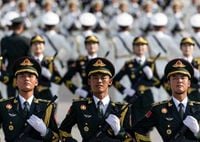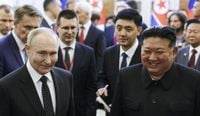Beijing is preparing to host a week of high-profile diplomacy and military spectacle, rolling out the red carpet for more than two dozen world leaders at two major events that will put China’s ambitions and alliances on full display. The annual summit of the Shanghai Cooperation Organization (SCO) in Tianjin and a massive military parade in Beijing marking the 80th anniversary of the end of World War II are set to draw an eclectic mix of dignitaries—a gathering that, according to multiple sources including the Associated Press and BBC, is as much about projecting power as it is about commemorating history.
The SCO summit, which kicks off on Sunday, August 31, 2025, in the bustling port city of Tianjin, is the first act in this diplomatic double feature. Established by China and Russia in 2001, the SCO has grown to include ten member states—among them India, Iran, Pakistan, and Belarus—with observer and dialogue partners spanning Southeast Asia and the Middle East. The summit’s guest list reads like a who’s who of regional politics: Russian President Vladimir Putin, Iranian President Masoud Pezeshkian, Indian Prime Minister Narendra Modi, Turkish President Recep Tayyip Erdogan, and Egyptian Prime Minister Mustafa Madbouly are all slated to attend, according to reporting by ABC News and the Associated Press. Representatives from Indonesia, Laos, Malaysia, and Vietnam will also be present, reflecting China’s ongoing efforts to deepen ties across Asia.
Yet, the summit’s inclusivity has its limits. While some leaders will stay on for the military parade in Beijing, others—most notably the heads of India, Egypt, and Turkey—will depart early or send lower-level officials in their stead. Their absence at the parade, as noted by ABC News, is a subtle nod to the diplomatic balancing act many nations must perform when it comes to China’s displays of military might.
The centerpiece of the week, however, is the “Victory Day” parade on Wednesday, September 3, 2025, in the heart of Beijing. This event, marking the 80th anniversary of Japan’s surrender and the end of World War II, is set to be the largest of its kind in China’s recent history. According to the Associated Press and Reuters, the parade will feature tens of thousands of troops, more than 100 aircraft, and a formidable array of tanks, missiles, and cutting-edge homegrown weaponry—including fighter jets, missile defense systems, and hypersonic weapons. The spectacle is highly choreographed, designed to project an image of a modernized, technologically advanced military under the firm leadership of President Xi Jinping.
But perhaps the most striking aspect of the parade is the lineup of international guests. Xi will be flanked by leaders of some of the world’s most heavily sanctioned nations: Putin of Russia, Kim Jong Un of North Korea, Pezeshkian of Iran, and Myanmar’s junta chief Min Aung Hlaing. This marks the first time Putin and Kim will appear in public alongside Xi at such an event, a tableau that Western analysts have dubbed the “Axis of Upheaval.” As reported by Reuters and the Associated Press, the parade is widely viewed as a show of solidarity against the West—a visual rebuke to the United States and its allies, none of whom are sending leaders to Beijing this week.
Kim Jong Un’s attendance is especially noteworthy. As confirmed by North Korean state media and the Chinese Foreign Ministry, this will be Kim’s first visit to China in six years and his first multilateral gathering with world leaders since taking power in late 2011. “We warmly welcome General Secretary Kim Jong Un to China to attend the commemorative events,” said Hong Lei, China’s assistant minister of foreign affairs, at a press conference. The move is seen by many analysts as an attempt by Kim to repair ties with Beijing, which remain critical for North Korea’s struggling economy. Despite Pyongyang’s growing cooperation with Russia—including sending troops to support Moscow’s war in Ukraine—about 97% of North Korea’s external trade still flows through China, according to Chinese trade data cited by the Associated Press.
Other notable guests at the parade include Cuban President Miguel Díaz-Canel, leaders from the Democratic Republic of Congo and Zimbabwe, as well as the Russia-friendly Serbian President Aleksandar Vucic and Slovakian Prime Minister Robert Fico. The absence of Western leaders is glaring but unsurprising; as the Associated Press notes, their decision to stay away is driven in part by ongoing tensions over Russia’s invasion of Ukraine and China’s perceived support for Moscow.
The parade is not just a geopolitical statement—it is also a carefully crafted message for domestic audiences. According to experts at the RAND Corporation, as reported by the Washington Times, the event serves to bolster national pride and reinforce the authority of the Chinese Communist Party at a time of economic uncertainty and international scrutiny. “The parade plays to where the [People’s Liberation Army] has been very successful—technological modernization. They get to show their wares, and they get to show them to an international community,” said Mark Cozad, a former Defense Intelligence Agency official now with RAND. The parade’s heavy anti-Japan focus, combined with rhetoric about standing up to “tyrannical powers,” is meant to evoke memories of past victories while warning adversaries—especially the United States and Taiwan—against antagonizing China.
The patriotic fervor surrounding the event has even spilled over into everyday life in Beijing. As Reuters reports, a local hair salon has been offering military-themed haircuts for children, with designs featuring the national flag and tanks shaved into their undercuts. “I thought, well how about offering these hair carving activities free of charge? As long as the little one is willing, we can carve it for free,” said hairdresser Wang Xueru, who has been eagerly anticipating the parade. Parents like Chen Nan see these activities as a way to inspire a sense of national pride in the next generation. “For our family, from the perspective of the motherland, a stronger China means we won’t be bullied anymore. And for my family, of course, peace is the most important thing—we just hope for lasting peace,” she told Reuters.
For Xi Jinping, the week’s events are an opportunity to assert China’s leadership on the world stage while rallying support at home. The parade and summit together send a clear message: China is ready to stand shoulder to shoulder with its allies, challenge Western dominance, and showcase its growing military prowess. Whether this display will ease tensions or deepen divisions remains to be seen, but for now, all eyes are on Beijing as it hosts a gathering unlike any other in recent memory.
As the dust settles on Tiananmen Square and the echoes of marching boots fade, the world will be left to ponder the significance of this carefully orchestrated show of strength—and what it portends for the future of global power politics.




